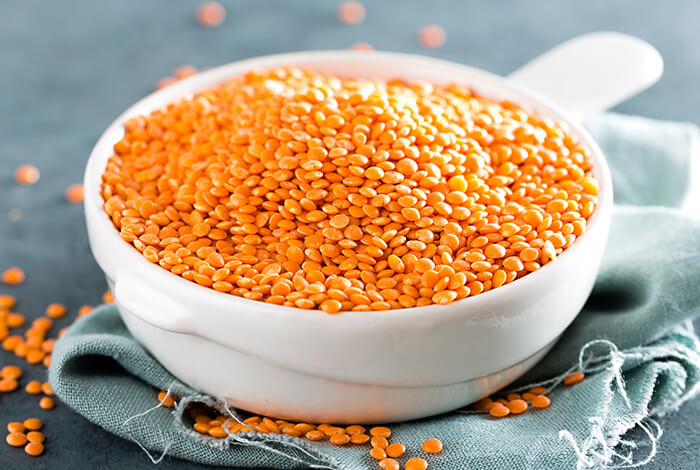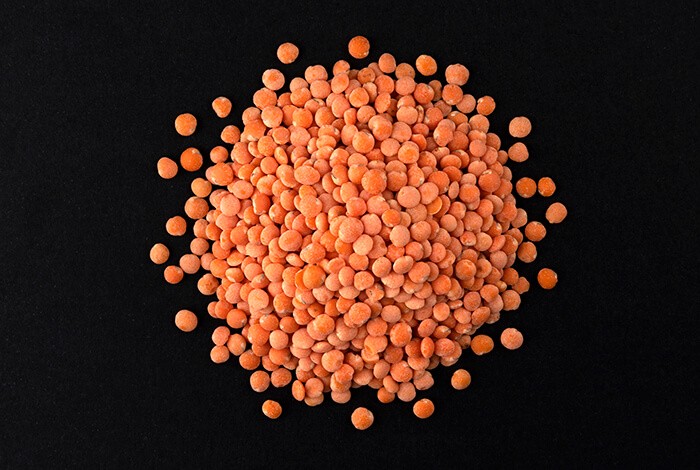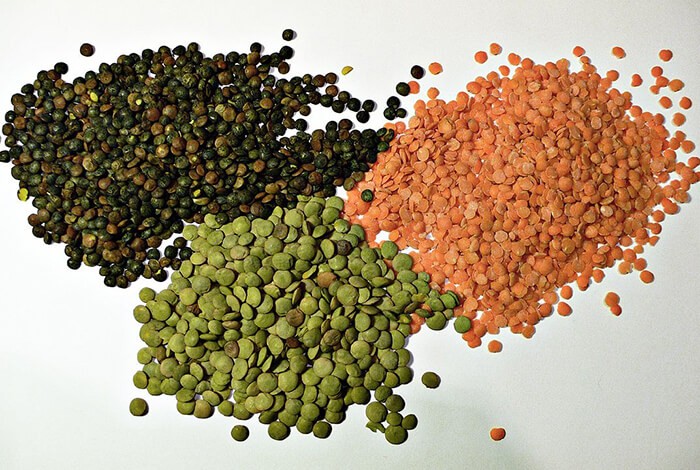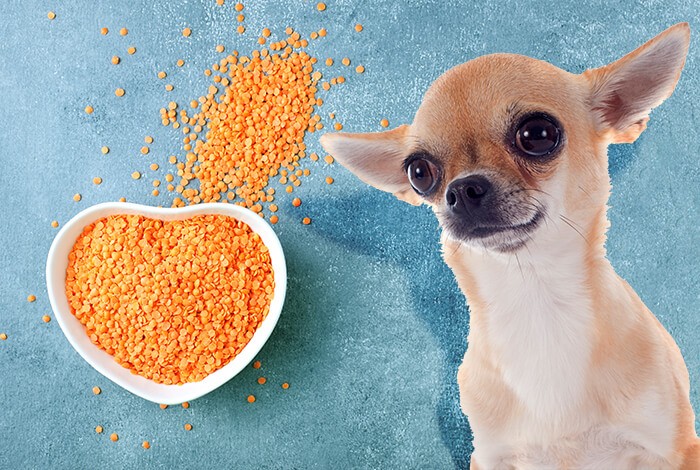![]() Reviewed By Joana Garrido DVM
Reviewed By Joana Garrido DVM
Yes, dogs can eat lentils. Lentils are an affordable source of valuable nutrients. These legumes are low in calories but rich in dietary fiber, proteins, iron, phosphorus, and other vitamins and minerals essential to dogs.
However, feeding lentils to dogs comes with its advantages and disadvantages. Let’s find out if your dog will benefit from having lentils in his diet.
The 5 Health Benefits of Lentils for Dogs
 Are lentils good for dogs?
Are lentils good for dogs?
Yes, lentils are good for dogs since they are low in calories and have a high nutritional value. When lentils are correctly incorporated into a dog’s diet, they provide the following health benefits:
1. Lentils are a Great Source of Vitamins and Minerals
Lentils are rich in essential nutrients. They contain high levels of:
- Vitamin B6
- Folate
- Iron
- Phosphorus
- Potassium
- Thiamine
Dogs can obtain significant amounts of dietary fiber, protein, and carbohydrates from lentils too.
Many dog owners ask, “Are lentils better than rice for dogs?” Yes, lentils are better than rice for dogs. When comparing their nutritional content, lentils contain more dietary fiber, protein, iron, and potassium than brown and white rice.
2. Lentils Aid Dogs Suffering from Diabetes
Lentils are commonly included in the diet of people with diabetes as they are low in sugar but high in nutritional content.
These health benefits are also helpful for diabetic dogs. Eating lentils gives diabetic dogs the nutrients they need without spiking up their blood glucose levels.
Dog owners who want to incorporate lentils into their pets’ regular diet should consult the vet first. They will determine the amount of lentils that is safe to add to a diabetic dog’s food.
3. Lentils Promote Healthy Digestive System and Weight
Lentils are high in fiber, which helps regulate the bowel movement of dogs. This supports smooth digestion, preventing constipation and other stomach problems.
Dietary fiber also helps dogs feel fuller while eating less. Adding lentils to the meals of overweight dogs can help improve their weight loss journey.
Dietary fiber, along with protein, also work hand in hand to flush out bodily toxins. As a result, good gut bacteria thrive in the digestive tract, improving the metabolization of nutrients.
4. Lentils Boost Energy for Dogs
Lentils in pet foods are often viewed as empty fillers. However, this is a misconception as these legumes are plant-based proteins with complex carbohydrates.
Both nutrients provide dogs with enough energy to stay active throughout the day. Protein is also essential for muscle development and muscle repair in dogs.
5. Lentils Support Good Blood Circulation
Lentils are a great source of iron, an important mineral used to produce red blood cells. It maintains a proper hemoglobin count, vital for sufficient oxygen transportation from the lungs to the tiniest cells.
This improves the metabolism of dogs and increases their energy. Healthy blood circulation lowers the chances of cardiovascular diseases too.
The 4 Health Risks of Feeding Lentils to Dogs
 When figuring out the answer to the question, “Can dogs eat lentils?” the disadvantages of these legumes should not be ignored. By knowing the drawbacks, dog owners will learn how to prepare and serve lentils to their pets safely.
When figuring out the answer to the question, “Can dogs eat lentils?” the disadvantages of these legumes should not be ignored. By knowing the drawbacks, dog owners will learn how to prepare and serve lentils to their pets safely.
1. Lentils are Difficult to Digest for Dogs
Research has been carried out on various starch sources, including lentils. Results show that lentils, along with peas, have the lowest digestibility rate in dogs.
Brewer’s rice and cassava proved to be the most digestible. These were then followed by corn and sorghum.
Keeping this in mind, feed your dog only minimal quantities of lentils. Exorbitant servings can lead to stomach upset, constipation, and other digestive maladies.
2. Uncooked Lentils Contain Toxins
All raw legumes, including lentils, naturally produce high concentrations of lectins. These are toxins that act as a defense mechanism in legumes. When ingested, they cause poisoning through bacterial growth in the digestive system.
Fortunately, there is a simple way to get rid of lectins, and that is through cooking. The process reduces these toxic compounds in lentils by 200 times.
How do you cook lentils for dogs? Boiling or steaming is the best way to cook lentils. These methods are proven to get rid of most lectins in these legumes. Avoid slow cooking since it is ineffective at getting rid of these toxins.
3. Lentils May Cause Mineral Deficiency in Dogs
Lentils contain a substance called phytates. They bind with minerals such as calcium, zinc, and iron. This prevents the absorption of these minerals into the body, causing mineral deficiencies.
Soaking lentils overnight will greatly reduce phytates in lentils. Since these compounds are not completely removed, do not add too much of these legumes to your dog’s food.
4. Lentils are Linked to Canine Dilated Cardiomyopathy (DCM)
Do lentils cause heart disease in dogs? Lentils were associated with the development of DCM in dogs. DCM is characterized by the enlargement of the heart, which may lead to sudden heart failure.
Certain ingredients in grain-free dog foods, such as beans, chickpeas, and potatoes, are thought to contribute to the disease. However, it cannot be surely said that lentils can cause DCM in dogs due to conflicting information.
It is best for dog owners to take extra precautions. Dog breeds that are highly at risk of developing DCM should not be given lentils as part of their regular diet. As for dogs not predisposed to this disease must be fed only small amounts of the legumes.

Which Lentils Are Good for Dogs?
 When prepared properly and served in the right amount, all types of lentils are good for dogs, including black, brown, green, yellow, and red. Always choose organically produced lentils since they are less exposed to pesticides.
When prepared properly and served in the right amount, all types of lentils are good for dogs, including black, brown, green, yellow, and red. Always choose organically produced lentils since they are less exposed to pesticides.
What about lentil soup? Can dogs eat lentil soup? No, this human food is not safe for dogs. Its ingredients usually include garlic and onions, which are toxic to canines.
Lentil soup can also cause stomach upset since it contains sodium, spices, and seasonings. These ingredients tend to be harsh on a dog’s stomach. Avoid sharing other store-bought lentil dishes with your dog for the same reasons.
How Much Lentils Should You Feed a Dog?
 A tablespoon of cooked lentils 1–2 times a week is sufficient to provide dogs with many nutrients without causing adverse effects.
A tablespoon of cooked lentils 1–2 times a week is sufficient to provide dogs with many nutrients without causing adverse effects.
As with all new foods, initially give your dog lentils in small amounts to avoid upsetting his digestive tract. Add more lentils to the next serving if he does not experience any problems. However, do not go beyond the suggested serving.

